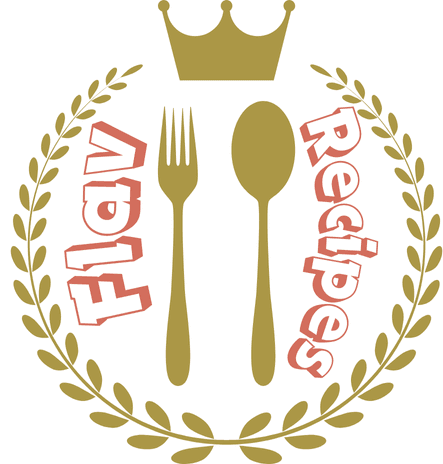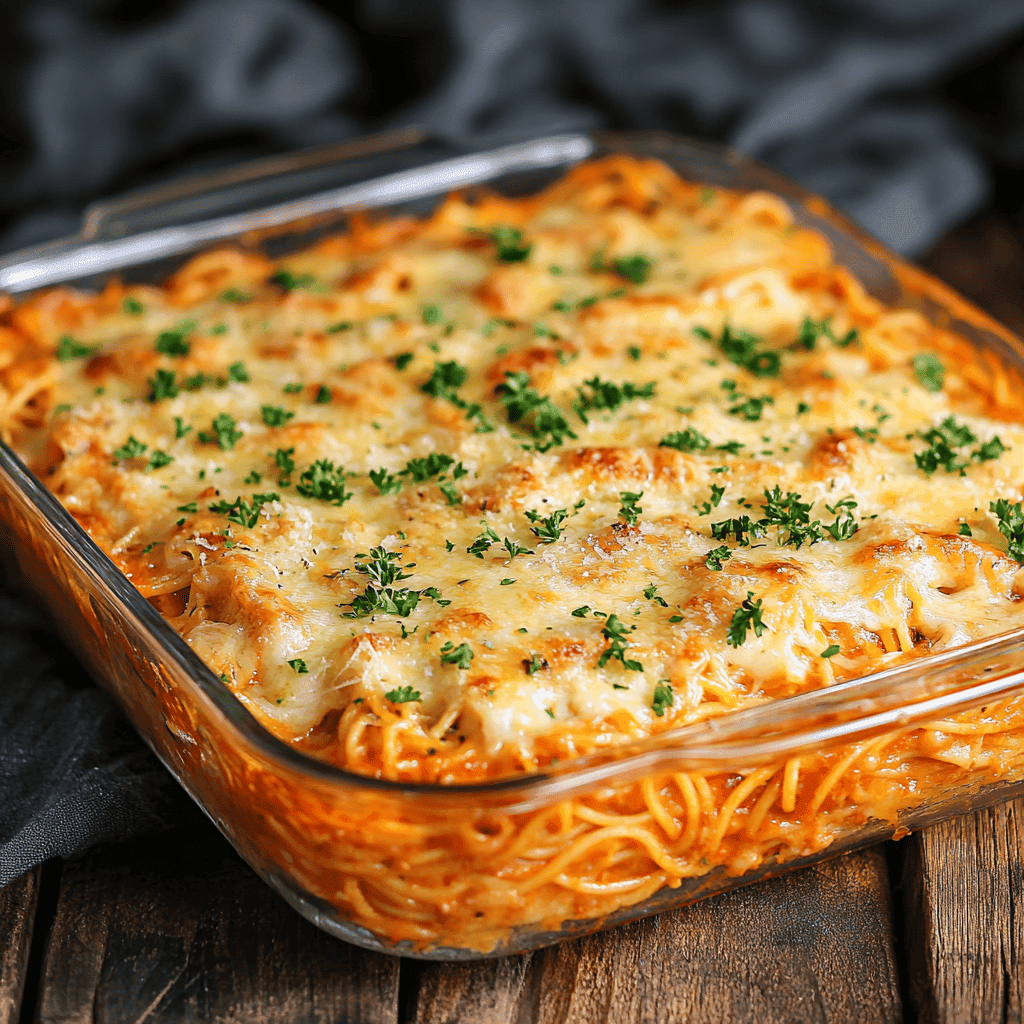Introduction
Spaghetti casserole is a warm and cheesy dish that’s perfect for families. It combines spaghetti with tomato sauce, melted cheese, and spices, baked into a delicious meal. This dish works for family dinners, potlucks, or a cozy night at home.
The best thing about spaghetti casserole is how simple it is to make. You can adjust it to fit your family’s tastes. Add extra cheese, mix in vegetables, or try a fun twist. This recipe is easy to follow and gives you great results.
In this guide, you’ll learn how to make spaghetti casserole step by step. We’ll also share helpful tips to make it even better.
Ingredients for Spaghetti Casserole
Before you start cooking, it’s important to gather all the ingredients. This recipe uses simple items you might already have in your kitchen. These ingredients make a casserole that’s cheesy, saucy, and absolutely delicious!
Main Ingredients:
- Spaghetti: Use regular or whole wheat spaghetti. For a gluten-free option, pick a suitable pasta brand.
- Tomato Sauce: Choose your favorite marinara or pasta sauce for rich flavor.
- Ground Meat: Use ground beef, turkey, or chicken, depending on your preference. You can also skip this for a vegetarian version.
- Cheese: Mozzarella and parmesan work great, but you can add cheddar or your favorite type for extra flavor.
- Seasonings: Salt, pepper, garlic powder, and Italian seasoning bring out the best taste.
- Vegetables (Optional): Add diced onions, bell peppers, or mushrooms for more nutrition.
Optional Add-Ons:
- Crushed Red Pepper: For a spicy kick.
- Herbs: Fresh basil or parsley as a garnish.
- Extra Cheese: To make it extra gooey and cheesy!
Substitutions for Special Diets:
- Dairy-Free: Use plant-based cheese alternatives.
- Vegetarian: Swap meat for plant-based crumbles or skip it entirely.
- Low-Carb: Try spaghetti squash instead of regular pasta.
Step-by-Step Cooking Process
Making spaghetti casserole is easy if you follow these steps. You’ll have a delicious dish ready to serve in no time!
Boil the Spaghetti
- Fill a large pot with water and bring it to a boil.
- Add a pinch of salt to the water for flavor.
- Cook the spaghetti according to the package instructions (usually 8–10 minutes).
- Drain the pasta and set it aside.
Tip: Slightly undercook the pasta since it will cook more in the oven.
Prepare the Meat and Sauce
- Heat a large skillet over medium heat.
- Add a tablespoon of oil, then brown the ground meat (beef, turkey, or chicken).
- Stir in garlic powder, salt, pepper, and Italian seasoning.
- Once the meat is cooked, pour in the tomato sauce and mix well. Let it simmer for 5–7 minutes.
Vegetarian Option: Skip the meat or use plant-based crumbles. Add diced vegetables like onions or bell peppers for extra flavor.
Combine the Spaghetti and Sauce
- In a large mixing bowl, combine the cooked spaghetti and the sauce.
- Toss everything together until the spaghetti is evenly coated with the sauce.
Layer the Casserole
- Preheat your oven to 375°F (190°C).
- Grease a large baking dish with cooking spray or a little oil.
- Add a layer of the spaghetti mixture to the dish.
- Sprinkle a generous amount of shredded mozzarella and parmesan cheese on top.
- Repeat the layers until all the spaghetti and cheese are used up, ending with a layer of cheese on top.

Bake the Casserole
- Cover the dish with aluminum foil to keep the cheese from browning too quickly.
- Bake in the preheated oven for 20 minutes.
- Remove the foil and bake for another 10–15 minutes, or until the cheese is bubbly and golden.
- Carefully take the casserole out of the oven and let it cool for 5–10 minutes before serving.
Your spaghetti casserole is now ready to enjoy! Serve it with garlic bread or a fresh salad for a complete meal.
Tips for the Perfect Spaghetti Casserole
To make your spaghetti casserole extra tasty and easy to prepare, follow these helpful tips. They’ll ensure your dish turns out just right every time!
Choose the Right Pasta
- Use spaghetti for the classic texture, but you can also try penne, rotini, or ziti. These shapes hold sauce well and add variety.
- Cook your pasta slightly underdone (al dente) so it doesn’t become mushy while baking.
Use High-Quality Cheese
- Shred your own cheese instead of using pre-shredded. Freshly grated cheese melts better and tastes richer.
- Mix different cheeses, like mozzarella, cheddar, and parmesan, for deeper flavor.
Balance the Sauce
- If your sauce tastes too tangy, add a pinch of sugar to balance the acidity.
- For a creamier casserole, mix in a little heavy cream or ricotta cheese with the tomato sauce.
Add Vegetables for Nutrition
- Diced bell peppers, mushrooms, zucchini, or spinach can be stirred into the sauce for added nutrients.
- Roast or sauté the vegetables before mixing them in for extra flavor.
Season to Taste
- Taste the sauce before mixing it with the spaghetti. Adjust the seasoning with salt, pepper, or Italian herbs as needed.
- Add red pepper flakes if you like a little heat.
Perfect Baking Techniques
- Cover the casserole with foil for the first part of baking. This traps moisture and prevents the cheese from burning.
- Remove the foil during the last 10 minutes of baking to let the cheese bubble and brown.
Make It Ahead
- Prepare the casserole the night before and store it in the fridge. Bake it when you’re ready to eat.
- If freezing, assemble the casserole without baking. Wrap it tightly in foil and freeze for up to three months.
Creative Toppings
- Sprinkle breadcrumbs mixed with melted butter and herbs on top before baking for a crunchy texture.
- Add fresh basil or parsley as a garnish after baking to brighten the flavors.
Serving and Storage Tips
Once your spaghetti casserole is baked to perfection, it’s time to serve and enjoy. Knowing how to serve, store, and reheat the casserole can help make the most of this family-friendly dish.

How to Serve Spaghetti Casserole
- Pair with Side Dishes: Spaghetti casserole pairs well with simple sides like garlic bread, Caesar salad, or roasted vegetables. These add variety and balance to your meal.
- Garnish for Flavor: Top the casserole with fresh parsley, basil, or a sprinkle of parmesan cheese before serving. This enhances both the taste and presentation.
- Portion Sizes: Use a sharp knife or spatula to slice the casserole into even portions. This makes serving easier, especially for larger groups.
Kid-Friendly Serving Tip: Serve smaller portions for kids and let them sprinkle on extra cheese or herbs for fun.
Storing Leftovers
- In the Refrigerator: Store leftovers in an airtight container. They’ll stay fresh for up to 3–4 days.
- In the Freezer: For longer storage, freeze individual portions or the entire casserole. Wrap tightly in plastic wrap or aluminum foil, then place in a freezer-safe container. It can last up to 3 months.
Reheating Spaghetti Casserole
- In the Oven: Preheat your oven to 350°F (175°C). Place the casserole in an oven-safe dish, cover with foil, and bake for 20–25 minutes, or until heated through.
- In the Microwave: For a quick option, heat individual portions in the microwave for 2–3 minutes. Cover with a microwave-safe lid to keep it moist.
Tips for Freezing and Reheating
- Freeze Before Baking: Assemble the casserole but don’t bake it. This keeps the texture fresh when reheated.
- Add Fresh Cheese: Sprinkle some extra cheese on top before reheating to refresh the flavors.
Making It a Meal Prep Option
Spaghetti casserole is perfect for meal prep. Bake a large dish on the weekend, portion it out, and store it in the fridge or freezer for easy weeknight meals. This saves time and ensures your family always has a hearty, homemade dinner ready to enjoy.
Frequently Asked Questions (FAQs)
Can I freeze spaghetti casserole?
Yes, spaghetti casserole freezes well. Assemble the casserole but don’t bake it. Wrap it tightly with plastic wrap and aluminum foil to prevent freezer burn. When ready to eat, let it thaw in the refrigerator overnight and bake as directed.
Can I use gluten-free pasta for this recipe?
Absolutely! Gluten-free spaghetti or any gluten-free pasta works perfectly. Just make sure not to overcook it, as gluten-free pasta can break apart more easily.
How can I make a vegetarian spaghetti casserole?
To make a vegetarian version, skip the meat and add vegetables like zucchini, bell peppers, mushrooms, or spinach. You can also use plant-based meat crumbles if desired.
What should I do if my casserole turns out too dry?
If your casserole is dry, it might need more sauce. Next time, mix in extra sauce with the spaghetti before baking. Covering the dish with foil during baking also helps retain moisture.
Can I make this casserole ahead of time?
Yes! You can prepare the casserole the night before and store it in the fridge. Bake it the next day when you’re ready to serve. This makes it an excellent option for busy schedules.
What are some creative toppings I can use?
Try adding crunchy breadcrumbs mixed with melted butter and Italian herbs on top. You can also sprinkle fresh parsley, basil, or more parmesan cheese as a garnish after baking.
Conclusion
Spaghetti casserole is a hearty, delicious dish that’s easy to prepare and loved by all ages. Its rich flavors, cheesy layers, and flexibility make it a perfect meal for any occasion. Whether you’re cooking for your family, hosting a gathering, or prepping meals for the week, this recipe is sure to please.
With simple ingredients and step-by-step instructions, you’re ready to make your own spaghetti casserole. Try adding your favorite twists or toppings to make it unique. Gather your loved ones, serve up this comforting dish, and enjoy the smiles around the table.
Looking for more casserole ideas? Check out this Chicken and Tater Tot Casserole for another family-friendly and comforting dish!
Happy cooking!

